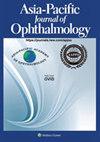How to diagnose glaucoma in myopic eyes by detecting structural changes?
IF 4.5
3区 医学
Q1 OPHTHALMOLOGY
引用次数: 0
Abstract
Myopia is rapidly escalating globally, especially in East and Southeast Asia, where its prevalence among younger populations reaches alarming levels of 80–90 %. This surge contributes to a myopia epidemic linked to several ocular complications, including glaucoma. As myopic individuals age, the risk of developing glaucoma increases, and an additional concern arises from the growing frequency of refractive surgeries among younger individuals, making precise optic nerve assessments critical before surgery. Evaluating the optic nerve head (ONH) in myopic eyes is challenging, as structural changes due to myopia often resemble glaucomatous alterations. Techniques such as optical coherence tomography (OCT) have improved the examination of ONH microstructures, but interpreting results remains complex due to potential false-positive findings. Myopic eyes exhibit unique changes, such as peripapillary atrophy and altered neuroretinal rim configurations, making it crucial to distinguish these from true glaucomatous signs. Recent advancements in OCT technology and the establishment of myopia-specific normative databases have enhanced diagnostic accuracy. Parameters such as minimum rim width, ganglion cell–inner plexiform layer thickness and temporal raphe sign show promise in differentiating between glaucomatous and nonglaucomatous changes. Ultimately, a comprehensive approach incorporating multiple OCT metrics is essential for accurately diagnosing glaucoma in myopic patients. By integrating various structural evaluations and leveraging advanced imaging techniques, clinicians can better navigate the complexities of glaucoma diagnosis amidst the challenges posed by myopia. This review highlights the need for increased attention and tailored strategies in managing glaucoma risk within this increasingly affected population.
如何通过检测结构变化诊断近视眼青光眼?
近视在全球范围内迅速升级,特别是在东亚和东南亚,其在年轻人群中的患病率达到80%至90%的惊人水平。这种激增导致近视流行,并与包括青光眼在内的几种眼部并发症有关。随着近视患者年龄的增长,患青光眼的风险也在增加,另外一个令人担忧的问题是年轻人越来越频繁地进行屈光手术,因此在手术前进行精确的视神经评估至关重要。评估视神经头(ONH)在近视的眼睛是具有挑战性的,因为结构变化引起的近视往往类似青光眼的改变。光学相干断层扫描(OCT)等技术改善了ONH微结构的检查,但由于潜在的假阳性结果,解释结果仍然很复杂。近视眼表现出独特的变化,如乳头周围萎缩和神经视网膜边缘结构改变,因此将其与真正的青光眼体征区分开来至关重要。最近OCT技术的进步和近视特异性规范数据库的建立提高了诊断的准确性。最小边缘宽度、神经节细胞-内丛状层厚度和颞缝征等参数对青光眼和非青光眼病变的鉴别具有重要意义。最终,综合多种OCT指标的方法对于准确诊断近视患者的青光眼至关重要。通过整合各种结构评估和利用先进的成像技术,临床医生可以在近视带来的挑战中更好地驾驭青光眼诊断的复杂性。这篇综述强调了在这一日益受影响的人群中,需要增加对青光眼风险的关注和定制策略。
本文章由计算机程序翻译,如有差异,请以英文原文为准。
求助全文
约1分钟内获得全文
求助全文
来源期刊

Asia-Pacific Journal of Ophthalmology
OPHTHALMOLOGY-
CiteScore
8.10
自引率
18.20%
发文量
197
审稿时长
6 weeks
期刊介绍:
The Asia-Pacific Journal of Ophthalmology, a bimonthly, peer-reviewed online scientific publication, is an official publication of the Asia-Pacific Academy of Ophthalmology (APAO), a supranational organization which is committed to research, training, learning, publication and knowledge and skill transfers in ophthalmology and visual sciences. The Asia-Pacific Journal of Ophthalmology welcomes review articles on currently hot topics, original, previously unpublished manuscripts describing clinical investigations, clinical observations and clinically relevant laboratory investigations, as well as .perspectives containing personal viewpoints on topics with broad interests. Editorials are published by invitation only. Case reports are generally not considered. The Asia-Pacific Journal of Ophthalmology covers 16 subspecialties and is freely circulated among individual members of the APAO’s member societies, which amounts to a potential readership of over 50,000.
 求助内容:
求助内容: 应助结果提醒方式:
应助结果提醒方式:


